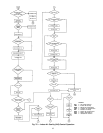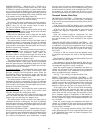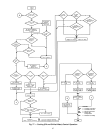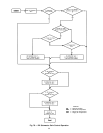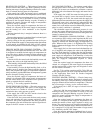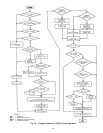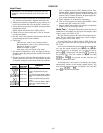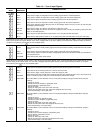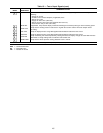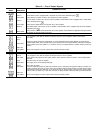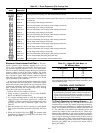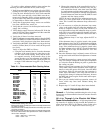SPACE TEMPERATURE RESET — The space tempera-
ture reset is used to reset the supply-air temperature set point
upward as the space temperature falls below the Occupied
Cooling set point. As space temperature falls below the cool-
ing set point, the space temperature is reset upward as a func-
tion of the reset ratio. The reset ratio is the degrees of change
in supply-air temperature per degree of space temperature
change. A reset limit specifies the maximum number of de-
grees the supply-air temperature may be raised. Both the re-
set ratio and the reset limits are user adjustable.
When the fan is ON, and the system is in the Occupied
mode, the control reads the space temperature sensor and
computes the reset value. If the reset value is greater than
the reset limit, the control uses the reset limit as the reset
value. The modified supply air temperature set point is de-
termined by adding the reset value to the configured supply
air temperature set point. This value is then used by the cool-
ing coil algorithm.
TWO-STEP DEMAND LIMITING (Available on Units
Connected to the Carrier Comfort Network Only) — If the
Demand Limit option is enabled, the control receives and
accepts redline alerts and loadshed commands from the Net-
work Loadshed option. See the CCN Loadshed manual for
additional information.
When a redline alert is received, the system limits the maxi-
mum volume (percent of fully open IGVs) per the user-
defined demand limit no. 1 set point.
When a loadshed command is received, the maximum vol-
ume is limited per the user-defined demand limit no. 2 set
point.
The maximum loadshed timer prevents the system from
remaining in Loadshed, if the control loses communications
with the Loadshed option. If the timer expires before the
loadshed command is cleared by the Loadshed option, the
control clears the loadshed command itself and returns
to normal control. The loadshed timer is factory set at
60 minutes.
MIXED-AIR DAMPER CONTROL— The mixed-air damper
control modulates the outside-air, return-air, and exhaust-air
dampers. When outside-air conditions are unsuitable for at-
mospheric cooling, the dampers are held at the minimum ad-
justable outside-air position. The mixed-air dampers are
modulated to maintain a mixed-air temperature equal to supply-
air temperature set point minus 3° F. The dampers can also
be modulated to maintain a user-configured mixed-air tem-
perature set point.
If the supply fan is OFF, the mixed-air dampers are held
closed to outside air and held open to return air. If the supply
fan is ON, and the system is not in the HEAT mode, the
system determines if outside-air conditions are suitable for
atmospheric cooling. The outside-air temperature is com-
pared to the space temperature. If the outside-air tempera-
ture is less than the space temperature, the system performs
either an enthalpy check using an outside-air enthalpy switch
or a differential enthalpy check.
If the outside conditions are suitable, the control uses the
mixed-air sensor to maintain the discharge temperature (when-
ever the mixed-air sensor option is installed). If the sensor
is not provided or fails, the control uses the supply-air sen-
sor to modulate the dampers and achieve the set point.
When the outside temperature is less than 40 F, the mixed-
air damper opening rate is limited to 5% per minute to pro-
tect against nuisance low temperature thermostat tripping and
coil freeze-up. Rate limiting is off when the dampers are closed.
102




